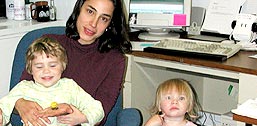|
jon langfordLinksCONSIDER Spin Magazine's spin on "25 years of Punk", check out their list of the 50 most essential punk records and their write up on the Ramones. SCAN the (maga)zine Punk Planet's Web site links to bands, activism, labels, forums, personal and music zines and more things "punk". We’ll never know for sure how it started because lots of people were messing with the sound that would become known as punk rock - British pub rockers, Iggy Pop and the Stooges, Richard Hell and The Voidoids, MC5, The New York Dolls and Television to name a few. The only thing punk rockers, critics and fans do agree on is that the Ramones first album was the true launch. There were 14 songs (nearly all of them composed of 3 chords) in 29 minutes. The sound was 1 part 60's AM radio fluff, 1 part glam rock, 1 part Velvet Underground "moody cool" and many parts youthful indignation. And the Ramones themselves were something new - long stringy hair with thuggish leather jackets and basketball sneakers. They were 4 boys from Queens who named their band after an alias once used by Paul McCartney. They were fast and funny and furiously doing it themselves. In the mid 70s, the Ramones played a series of gigs in London at Dingwall's. The audience was full of pub rockers who would go on to start their own punk bands. At the same time, British impressario Malcolm McClaren was looking for a way to promote his London boutique, Sex. McClaren is credited with "creating" the Sex Pistols as a musician models. The Pistols thought of themselves as ironic, arch and, essentially, as salesmen. But the British punk bands that followed them, like The Clash, were dead serious. They were political and they meant it. While the Ramones were looking disheveled and dissaffected, acts like The Buzzcocks and The Sex Pistols went with a bloodier look -- they had short spikey hair, thick chain jewelry and ripped up everything (including, sometimes, skin). And while the British bands were famously pissed off, the Ramones were as bemused as they were angry. And, everyone was bored. Regular rock -- the music you heard on the radio - had become a bloated behemoth of virtuostic soullessness (imagine!). What the Beat Poets had been to the likes of T.S. Eliot and Ezra Pound so Joey, Johnny, Sid, et al took on 70's rock, stripping it down and revving it up. Punk was live. The Ramones were regulars at a downtown Manhattan bar called CBGB which became ground zero for America’s punk acts. It didn’t matter if you couldn’t really play, the idea was to do it yourself and to not sound like “establishment” rock. The battle cries were sometimes coherent (“No future”), sometimes not (“Oi,Oi,Oi”), and sometimes they were just plain fun to say, “Hey Ho, let’s go.” Yeah, there were the attending vices -- drugs, alcoholism, self-abuse, audience abuse, but they were simply attendants to the movement, not its building blocks. Of course punk eventually found its way onto the radar screen of popular culture and became uniform. Or did it? Most punk rockers will tell you that punk is actually an attitude, not a style of music. Punk rock is about being an outsider and making the world reflect you. It’s about being loud and true and doing it yourself. That’s why so many bands since the Ramones - X, Sonic Youth, Joy Division, PIL, Black Flag, Fugazi, Mission of Burma (to name a few) - consider themselves punk. (And it's why some of these bands, although openly and staunchly anti-drugs, self-abuse, etc., can and do consider themselves punk.) In the end punk rock is what punk rockers do and that’s the true beauty of it - anyone, anywhere can be punk. So don’t just sit there - act. Contents Copyright 2001, National Public Radio |
|||||||


